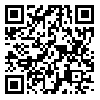Volume 5, Issue 2 (13 2012)
ijhe 2012, 5(2): 245-252 |
Back to browse issues page
Download citation:
BibTeX | RIS | EndNote | Medlars | ProCite | Reference Manager | RefWorks
Send citation to:



BibTeX | RIS | EndNote | Medlars | ProCite | Reference Manager | RefWorks
Send citation to:
Golbabaie F, Monazam Esmaieli M R, Hemmatjou R, nasiri P, Pour Yaaghoub G R, Hosseini M. Comparing the Heat Stress (DI, WBGT, SW) Indices and the Men Physiological Parameters in Hot and Humid Environment. ijhe 2012; 5 (2) :245-252
URL: http://ijhe.tums.ac.ir/article-1-31-en.html
URL: http://ijhe.tums.ac.ir/article-1-31-en.html
Farideh Golbabaie 
 , Mohammad Reza Monazam Esmaieli
, Mohammad Reza Monazam Esmaieli 
 , Rasoul Hemmatjou *
, Rasoul Hemmatjou * 
 1, Parvin Nasiri
1, Parvin Nasiri 
 , Gholam Reza Pour Yaaghoub
, Gholam Reza Pour Yaaghoub 
 , Mostafa Hosseini
, Mostafa Hosseini 


 , Mohammad Reza Monazam Esmaieli
, Mohammad Reza Monazam Esmaieli 
 , Rasoul Hemmatjou *
, Rasoul Hemmatjou * 
 1, Parvin Nasiri
1, Parvin Nasiri 
 , Gholam Reza Pour Yaaghoub
, Gholam Reza Pour Yaaghoub 
 , Mostafa Hosseini
, Mostafa Hosseini 

1- , r.hemmatjo@yahoo.com
Abstract: (13294 Views)
MicrosoftInternetExplorer4 Background and Objectives: Heat stress is considered as a serious threat to the
health and safety of workers in many industries, including petrochemical and
steel. Assessment of the heat stress is important from the disease prevention
point of view and also for the safety and performance of workers at workplace.
Although there are many indices to evaluate the heat stress, it is hard to
select an applicable index for a wide range of weather conditions. The purpose
of the study was to develop an optimal index based on physiological parameters
in a petrochemical industry.
Materials and Methods: The study was conducted in a petrochemical industry located in Assaluyeh (south of Iran). Twenty one healthy young men at different levels of fitness and heat acclimation volunteered to participate in the study. Physiological parameters including heart rate, systolic and diastolic blood pressure, skin temperature and oral temperature were measured during the working day over two consecutive weeks. Simultaneously, we measured the climatic parameters required to calculate the wet bulb globe temperature (WBGT), required sweat rate (SWreq), and the discomfort index (DI) indices.
Results: All the measurements took place on 2 sites: Kar (working place) and Paziresh (resting room). Our results showed that the mean values of indices and physiological parameters in Kar for both acclimated and unacclimated groups were significantly higher than Paziresh (P<0.05). There was the strongest linear correlation between WBGT and heart rate (0.731), systolic blood pressure (0.695) and diastolic blood pressure (0.375) and skin temperature (0.451) respectively. The amounts of DI were 0.725, 0.446, 0.352, and 0.689 respectively. But the strongest linear relationship existed between SWreq and deep body temperature (0.766).
Conclusion: There were significant differences in the present indices and physiological parameters of Kar and Paziresh, confirming the previous studies findings. Finally, WBGT was considered optimal index and the results revealed the almost perfect linear correlation between WBGT and heart rate. We propose WBGT can be the most applicable index for evaluating heat stress in this climate.
Materials and Methods: The study was conducted in a petrochemical industry located in Assaluyeh (south of Iran). Twenty one healthy young men at different levels of fitness and heat acclimation volunteered to participate in the study. Physiological parameters including heart rate, systolic and diastolic blood pressure, skin temperature and oral temperature were measured during the working day over two consecutive weeks. Simultaneously, we measured the climatic parameters required to calculate the wet bulb globe temperature (WBGT), required sweat rate (SWreq), and the discomfort index (DI) indices.
Results: All the measurements took place on 2 sites: Kar (working place) and Paziresh (resting room). Our results showed that the mean values of indices and physiological parameters in Kar for both acclimated and unacclimated groups were significantly higher than Paziresh (P<0.05). There was the strongest linear correlation between WBGT and heart rate (0.731), systolic blood pressure (0.695) and diastolic blood pressure (0.375) and skin temperature (0.451) respectively. The amounts of DI were 0.725, 0.446, 0.352, and 0.689 respectively. But the strongest linear relationship existed between SWreq and deep body temperature (0.766).
Conclusion: There were significant differences in the present indices and physiological parameters of Kar and Paziresh, confirming the previous studies findings. Finally, WBGT was considered optimal index and the results revealed the almost perfect linear correlation between WBGT and heart rate. We propose WBGT can be the most applicable index for evaluating heat stress in this climate.
!mso]>
Type of Study: Research |
Subject:
General
Received: 2011/11/19 | Accepted: 2012/02/9 | Published: 2013/09/30
Received: 2011/11/19 | Accepted: 2012/02/9 | Published: 2013/09/30
Send email to the article author
| Rights and Permissions | |
 |
This work is licensed under a Creative Commons Attribution-NonCommercial 4.0 International License. |



